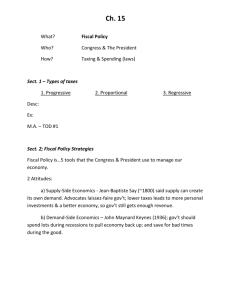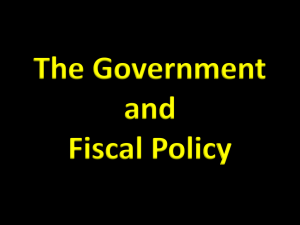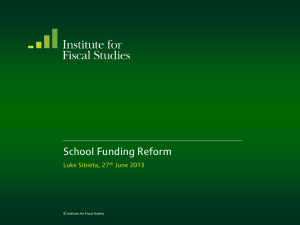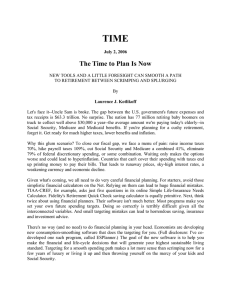Our fiscal future Paul Johnson © Institute for Fiscal Studies
advertisement
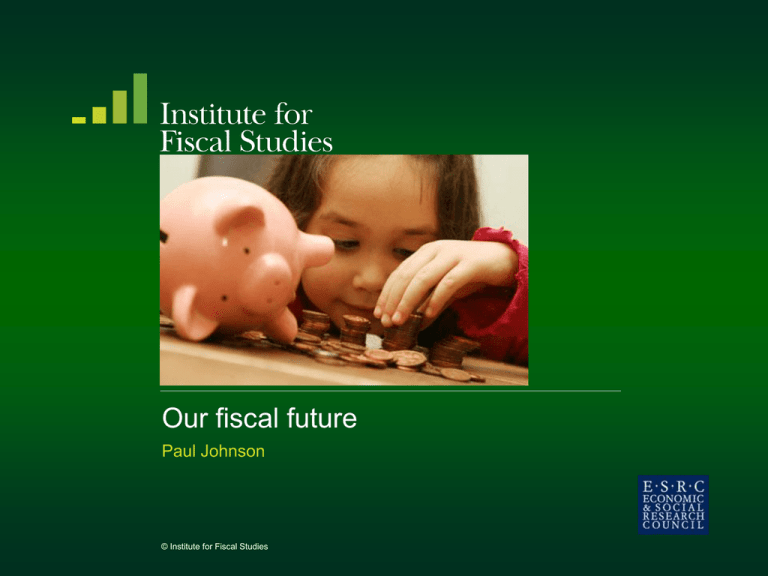
Our fiscal future Paul Johnson © Institute for Fiscal Studies Our fiscal future • The spending review period and medium term outlook • The long term outlook © Institute for Fiscal Studies The hole in the public finances Percentage of national income 55.0 Permanent damage = 7.5% of GDP (£114bn) Total spending (Budget 2008) Receipts (Budget 2008) 50.0 45.0 40.0 35.0 © Institute for Fiscal Studies Notes and sources: see Figure 3.6 of The IFS Green Budget: February 2012. 2016–17 2015–16 2014–15 2013–14 2012–13 2011–12 2010–11 2009–10 2008–09 2007–08 2006–07 2005–06 2004–05 2003–04 2002–03 2001–02 2000–01 1999–00 1998–99 1997–98 1996–97 30.0 The cure (November 2011): 8.1% national income consolidation over 7 years Nov 2011: 7.5% national income (£114bn) hole in public finances Percentage of national income 9 Other current spend Debt interest Benefits Investment Tax increases 8 7 6 5 80% 4 3 2 1 20% 0 2010–11 2011–12 2012–13 2013–14 2014–15 2015–16 2016–17 © Institute for Fiscal Studies Notes and sources: see Figure 3.5 of The IFS Green Budget: February 2012. Spending and revenues brought back to precrisis levels Percentage of national income 55.0 Total spending (Budget 2008) Receipts (Budget 2008) Receipts (no action) Total spending (no action) 50.0 45.0 40.0 35.0 © Institute for Fiscal Studies Notes and sources: see Figure 3.6 of The IFS Green Budget: February 2012. 2016–17 2015–16 2014–15 2013–14 2012–13 2011–12 2010–11 2009–10 2008–09 2007–08 2006–07 2005–06 2004–05 2003–04 2002–03 2001–02 2000–01 1999–00 1998–99 1997–98 1996–97 30.0 7-year 6-year squeeze on public service spending 16.2% cut over 7 years 9.3% cut over 7 years 10 5 0 ConLib Historic 1980–81 Labour 1970–71 -5 7 year moving average © Institute for Fiscal Studies Note: Figure shows total public spending less spending on welfare benefits and debt interest. 2015–16 2010–11 2005–06 2000–01 1995–96 1990–91 1985–86 1975–76 1965–66 1960–61 1955–56 -10 1950–51 Annual percentage real increase 15 Pattern of DEL changes 2010-11 to 2014-15 International Development 37.8% Energy and Climate Change 6.5% NHS (England) 1.0% Defence -8.2% Education -11.9% Total -11.5% Transport -14.5% CLG: Local Government -20.7% Home Office -22.0% Justice -27.2% Environment, Food and Rural Affairs -27.6% Business, Innovation and Skills -31.2% Culture, Media and Sport CLG: Communities -100% -46.1% -71.3% -80% -60% -40% -20% 0% Percentage real increase, 2010–11 to 2014–15 © Institute for Fiscal Studies 20% 40% 230 210 Health 190 170 150 Public service spending 130 110 90 Education 70 50 1998–99 1999–00 2000–01 2001–02 2002–03 2003–04 2004–05 2005–06 2006–07 2007–08 2008–09 2009–10 2010–11 2011–12 2012–13 2013–14 2014–15 2015–16 2016–17 Real spending (1998-99 = 100) Similar priorities (in different directions) Defence © Institute for Fiscal Studies Notes and sources: see Figure 3.12 of The IFS Green Budget: February 2012. Household incomes falling to unprecedented degree Median net household income (indexed to 2009=100) 100 99 98 97 96 95 94 93 92 91 90 2009-10 2010-11 2011-12 2012-13 2013-14 2014-15 Sources: Department for Work and Pensions’ HBAI series; IFS calculations and projections using Family Resources Survey. © Institute for Fiscal Studies 2015-16 Continuing change in the shape of the state • Health, social protection and education account for two thirds of public spending • Up from less than half in 1979 • Increase results from health and social protection – Education has merely maintained its share • Defence, housing and support for business and industry have taken the strain © Institute for Fiscal Studies Public spending in 2010-11 Social protection 10% 1% 3% Personal social services 29% 2% Health Education 6% Transport Defence 5% Public order and safety Gross debt interest 6% 4% 3% Housing TIEEE AFF 13% © Institute for Fiscal Studies 18% Other Public spending in 1978-79 Social security 9% 1% Personal social services 23% Health 9% Education Transport 6% 2% Defence Law, order & protection 10% 10% Gross debt interest Housing TIEEE 4% 12% 10% © Institute for Fiscal Studies 4% AFFF Other Going forward state is set to change further • Demographics will drive further change • OBR projections suggest that health and pensions alone could account for more than a half of noninterest spending by 2060 © Institute for Fiscal Studies Going forward state is set to change further • Demographics will drive further change • OBR projections suggest that health and pensions alone could account for more than a half of noninterest spending by 2060 • And there are additional pressures on tax receipts – Notably on petrol and from north sea oil – Perhaps from corporation tax © Institute for Fiscal Studies This creates some major pressures • At least another £100 billion in tax rises or spending cuts will need to be found over a – relatively long – period from 2020 • Three core drivers: – Demographics – Structure of spending commitments – Stability of tax base © Institute for Fiscal Studies This creates some major pressures • At least another £100 billion in tax rises or spending cuts will need to be found over a – relatively long – period from 2020 • Three core drivers: – Demographics – Structure of spending commitments – Stability of tax base • There are only three choices: – Increase total taxes to accommodate pressures – Reform and rein in health and pension spending – Cut other areas of spending © Institute for Fiscal Studies Conclusions • £114 billion hole in public finances • Planned fiscal consolidation: 8.1% of national income – Most of the spending cuts are still to come • Long term squeeze on household incomes – Real increases in energy prices a big issue for those on low incomes • The longer term outlook is daunting too – Continued move to the “welfare state” offers challenges – Main sources of “environmental” taxation are falling © Institute for Fiscal Studies


